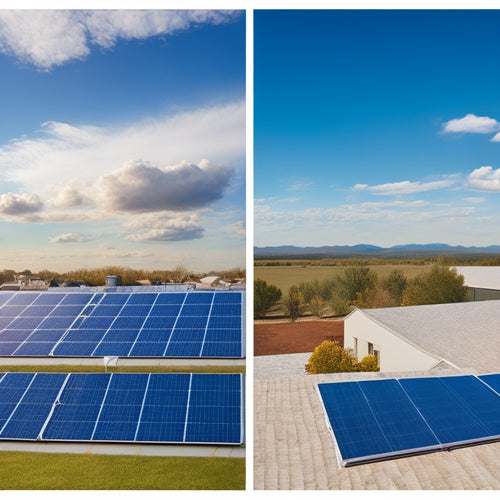
How to Integrate a Residential Solar Battery With Your Solar Panel System
Share
You integrate a residential solar battery with your solar panel system by first evaluating your energy needs, considering peak usage hours, total daily consumption, and energy-intensive appliances. Next, select the right battery type, considering options like lithium-ion and lead acid batteries based on efficiency, lifespan, and cost. Size your solar battery system accordingly, calculating daily energy usage and desired backup duration. Then, install the unit, ensuring a safe and secure electrical connection. Finally, configure system monitoring tools to track performance and optimize energy storage, and you'll be well on your way to revealing a reliable and efficient energy storage solution customized to your specific needs, with more information waiting to be discovered.
Key Takeaways
- Assess energy needs by reviewing past electricity bills and considering energy-intensive appliances to ensure a reliable energy storage system.
- Choose the right battery type (lithium-ion or lead acid) based on factors like cost, lifespan, and environmental impact.
- Size the solar battery system correctly by calculating daily energy usage, desired backup duration, and peak demand.
- Install the solar battery unit safely and correctly by following manufacturer instructions and ensuring a suitable location.
- Monitor and optimize the system's performance using software and tracking key metrics to maximize energy storage capacity and efficiency.
Assessing Your Energy Needs
Typically, a solar battery system is designed to provide a specific amount of energy to your home or business during periods of low sunlight or at night.
To determine the right size of your solar battery system, you'll need to evaluate your energy needs. Start by reviewing your current energy consumption patterns. Check your past electricity bills to identify your peak energy usage hours and total daily energy consumption. This will help you determine how much energy you need to store in your solar battery system to meet your energy demands during periods of low sunlight or at night.
You should also consider the types of appliances and devices you plan to power with your solar battery system. For example, if you have energy-intensive appliances like electric heaters or pumps, you'll need a larger solar battery system to guarantee you have enough energy to power them.
Additionally, consider the battery lifespan and how it will impact your energy needs over time. By accurately evaluating your energy needs, you can design a solar battery system that provides reliable energy storage and meets your unique energy requirements.
Selecting the Right Battery Type
With your energy needs assessed, you can now focus on selecting the right battery type for your solar panel system.
Two primary options to take into account are lithium-ion batteries and lead acid alternatives. Lithium-ion batteries offer higher efficiency ratings and longer lifespans, typically ranging from 10 to 15 years. In contrast, lead acid batteries have shorter lifespans, typically 5 to 7 years, but are more cost-effective.
When evaluating lithium options, look for brands with high reliability and extensive warranty terms. Reflect on the environmental impact of each battery type, as lithium-ion batteries tend to have a lower carbon footprint.
Cost comparisons are essential, balancing the upfront costs against the long-term benefits of each option. Additionally, assess the battery's depth of discharge, round-trip efficiency, and charging/discharging rates to guarantee it meets your energy needs.
Sizing Your Solar Battery System
You'll need to determine your battery capacity needs based on your energy usage patterns and the number of days you want the system to provide backup power during an outage.
To do this, you'll need to calculate your system load requirements, including the total wattage of the appliances and devices you want to power.
Battery Capacity Needs
Determine your energy requirements to accurately size your solar battery system. This involves calculating your daily energy usage in kilowatt-hours (kWh). You can do this by reviewing your past electricity bills or using an energy monitoring system.
Consider your energy usage patterns, such as peak hours and nighttime usage.
Next, consider the depth of discharge (DOD) you're comfortable with. A higher DOD means you'll use more of the battery's capacity, but it may reduce the battery lifespan. A lower DOD provides a buffer for unexpected energy needs, but it may increase the upfront cost.
Typically, a DOD of 50% is recommended for residential solar batteries.
System Load Requirements
Now that you've calculated your daily energy usage and decided on a comfortable depth of discharge, it's time to size your solar battery system to meet your specific load requirements. This involves determining the peak demand of your home, which is the maximum amount of power your appliances and devices require at any given time. You can calculate peak demand by adding up the wattage of all your appliances, lights, and devices, and then multiplying that number by the number of hours you use them per day.
When sizing your solar battery system, it's crucial to take into account energy efficiency. A more energy-efficient system will require smaller batteries, reducing overall costs.
You should also take into account the type of appliances you use, as some, like refrigerators and air conditioners, require more power than others. By accurately evaluating your system load requirements, you can guarantee your solar battery system provides reliable backup power and optimizes your energy efficiency.
A well-designed system will meet your peak demand, provide sufficient backup power, and minimize energy waste.
Installing the Solar Battery Unit
Installing the Solar Battery Unit
Before beginning the installation process, guarantee you have a clear understanding of the solar battery unit's electrical and mechanical requirements, as outlined in the manufacturer's documentation. This will guarantee a safe and efficient battery installation.
Take note of the recommended installation location, as it may affect the unit's performance and lifespan.
Next, prepare the installation site by guaranteeing a clean, dry, and level surface. Clear the area of any flammable materials and obstacles that may hinder the installation process.
Wear appropriate safety gear, including gloves and safety glasses, to protect yourself from electrical shock and other hazards.
Follow the manufacturer's instructions to connect the solar battery unit to your solar panel system. Guarantee all electrical connections are secure and meet the required safety standards.
Perform a series of safety checks to verify the installation meets the necessary safety precautions. Once complete, you'll be ready to configure your system monitoring tools to optimize your solar battery's performance.
Configuring System Monitoring Tools
You'll need to configure your system monitoring tools to track your solar battery's performance and identify areas for optimization. This involves setting up monitoring software that can collect and analyze data from your solar panel system and battery unit.
The software should provide data visualization features, allowing you to view real-time data on energy production, consumption, and storage. You'll need to connect your solar panel system and battery unit to the monitoring software, which may involve installing sensors, gateways, or other hardware.
Once connected, the monitoring software will provide you with significant understandings into your system's performance. You'll be able to track key performance indicators such as energy yield, charging and discharging rates, and round-trip efficiency.
This data will help you identify areas for improvement, such as optimizing charging schedules or adjusting your energy usage habits. By configuring your system monitoring tools correctly, you'll be able to maximize the benefits of your solar battery system and make data-driven decisions to reduce your energy costs.
Optimizing Energy Storage Performance
You'll want to maximize your energy storage capacity to guarantee you're getting the most out of your solar panel system.
Optimizing power output is also vital, as it directly impacts how efficiently your solar battery can supply power to your home.
Additionally, monitoring your battery's health is essential to prevent degradation and extend its lifespan.
Energy Storage Capacity
As your solar panel system generates excess energy, a vital aspect of optimizing energy storage performance lies in selecting a solar battery with sufficient energy storage capacity. This capacity determines how much energy you can store for later use, and it's important to choose a battery that can meet your energy needs.
When evaluating energy storage capacity, consider your daily energy requirements and the amount of excess energy your solar panel system generates. A battery with a higher capacity can store more energy, but it also increases the upfront cost. You'll need to strike a balance between capacity and cost.
Another significant factor is the battery's lifespan, which is affected by the number of discharge cycles it can handle. Discharge cycles refer to the number of times a battery can be fully charged and discharged before its capacity degrades.
Look for a battery with a high cycle life to guarantee it lasts for many years to come. By selecting a solar battery with the right energy storage capacity, you can maximize your energy independence and reduce your reliance on the grid.
Power Output Optimization
Optimizing energy storage performance hinges on power output optimization, which involves fine-tuning your solar battery's output to confirm it aligns with your energy needs.
You'll want to ascertain your battery is configured to provide the right amount of power at the right time. This means adjusting the discharge rates to match your peak energy usage periods. For example, if you have a high-energy appliance running during the evening, you'll want to prioritize discharging your battery during this time.
You'll also need to take into account the charge cycles of your battery. The more charge cycles your battery can handle, the longer its lifespan will be.
By optimizing your power output, you can reduce the number of charge cycles your battery goes through, ultimately extending its lifespan. Additionally, you'll want to monitor your battery's state of charge to verify it's not over-discharged or over-charged, as this can negatively impact its performance.
Battery Health Monitoring
Fine-tuning your power output is just one aspect of maximizing your energy storage performance. To guarantee your residential solar battery operates at its best, you need to keep a close eye on its health. This is where battery health monitoring comes in.
By tracking your battery's state of charge, depth of discharge, and temperature, you can identify potential issues before they become major problems. This proactive approach enables you to take corrective action, extending your battery's lifespan and preventing performance degradation.
Effective battery lifespan management involves monitoring key performance indicators, such as capacity, voltage, and internal resistance. By analyzing these metrics, you can detect signs of wear and tear, allowing you to schedule maintenance and replacements accordingly.
Performance degradation tracking also helps you optimize your battery's charging and discharging cycles, guaranteeing it operates within its design parameters. By staying on top of your battery's health, you can enjoy a longer, more reliable, and more efficient energy storage system.
Frequently Asked Questions
Can I Use My Solar Battery for Backup Power During Outages?
You can use your solar battery for backup power during outages, achieving energy independence and reliable energy supply, as long as you've installed a compatible inverter and configured your system to provide backup power mode operation.
Are Solar Batteries Compatible With Existing Solar Panel Systems?
"When it rains, it pours," but don't worry, you're not stuck in the dark - most solar batteries are compatible with existing systems, as long as you choose the right battery type and meet specific installation requirements that fit your setup.
How Long Does It Take to Charge a Solar Battery Fully?
When you're relying on solar power, you're probably wondering how long it takes to fully charge your battery. This depends on your battery capacity and charging efficiency - for example, a 10kWh battery with 90% efficiency might take around 5-6 hours to fully charge from a 5kW solar array.
Can I Add More Batteries to My System in the Future?
Think of your solar battery system like a LEGO castle – you can always add more blocks (batteries) later! You're not locked in; you can expand your battery capacity through future upgrades, making battery expansion a breeze, so you can scale up as your energy needs grow.
Do Solar Batteries Require Regular Maintenance?
You'll be relieved to know that solar batteries require minimal maintenance, but you'll still need to follow a regular maintenance schedule to guarantee peak performance and extend battery lifespan, typically 10-15 years, depending on the manufacturer's guidelines.
Conclusion
You've now revealed the secret to utilizing the full potential of your solar panel system! With a residential solar battery integrated into your setup, you'll be saving a small fortune on energy bills and reducing your carbon footprint to near zero. Your energy independence will be so strong, you'll be the envy of the entire neighborhood! By following these steps, you'll be maximizing your energy storage performance and basking in the glory of a sustainable future - all while watching your energy savings skyrocket!
Related Posts
-

What You Need to Know About Permits and Inspections
You need to navigate the complex landscape of permits and inspections to guarantee your project complies with local z...
-

Why Homeowners Are Embracing DIY Energy Independence
By taking control of your energy needs, you're breaking free from the uncertainty of utility bills and embracing a se...
-

Tracking Solar Panels Vs Fixed Panels Cost Savings
When considering solar panel options, you'll want to weigh the cost savings of tracking solar panels versus fixed pan...


